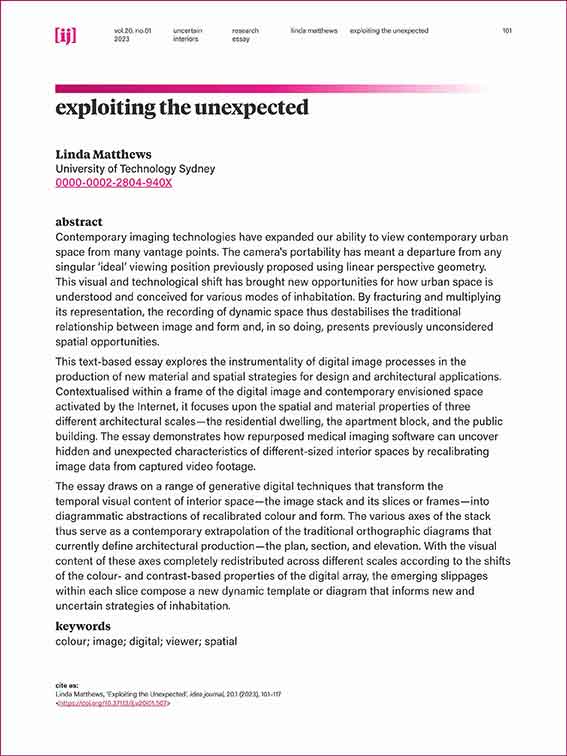Exploiting the Unexpected
Main Article Content
Abstract
Contemporary imaging technologies have expanded our ability to view contemporary urban space from many vantage points. The camera's portability has meant a departure from any singular ‘ideal’ viewing position previously proposed using linear perspective geometry. This visual and technological shift has brought new opportunities for how urban space is understood and conceived for various modes of inhabitation. By fracturing and multiplying its representation, the recording of dynamic space thus destabilises the traditional relationship between image and form and, in so doing, presents previously unconsidered spatial opportunities.
This text-based essay explores the instrumentality of digital image processes in the production of new material and spatial strategies for design and architectural applications. Contextualised within a frame of the digital image and contemporary envisioned space activated by the Internet, it focuses upon the spatial and material properties of three different architectural scales — the residential dwelling, the apartment block, and the public building. The essay demonstrates how repurposed medical imaging software can uncover hidden and unexpected characteristics of different-sized interior spaces by recalibrating image data from captured video footage.
The essay draws on a range of generative digital techniques that transform the temporal visual content of interior space — the image stack and its slices or frames — into diagrammatic abstractions of recalibrated colour and form. The various axes of the stack thus serve as a contemporary extrapolation of the traditional orthographic diagrams that currently define architectural production — the plan, section, and elevation. With the visual content of these axes completely redistributed across different scales according to the shifts of the colour- and contrast-based properties of the digital array, the emerging slippages within each slice compose a new dynamic template or diagram that informs new and uncertain strategies of inhabitation.
Article Details
Author/s and or their institutions retain copyright ownership over works submitted to Idea Journal, and provide the Interior Design / Interior Architecture Educators Association with a non–exclusive license to use the work for the purposes listed below:
- Make available/publish electronically on the Idea Journal website
- Publish as part of Idea Journal's online open access publications
- Store in electronic databases, on websites and CDs/DVDs, which comprise of post-publication articles to be used for publishing by the Interior Design / Interior Architecture Educators Association.
Reproduction is prohibited without written permission of the publisher, the author/s or their nominated university. The work submitted for review should not have been published or be in the process of being reviewed by another publisher. Authors should ensure that any images used in their essays have copyright clearance.

